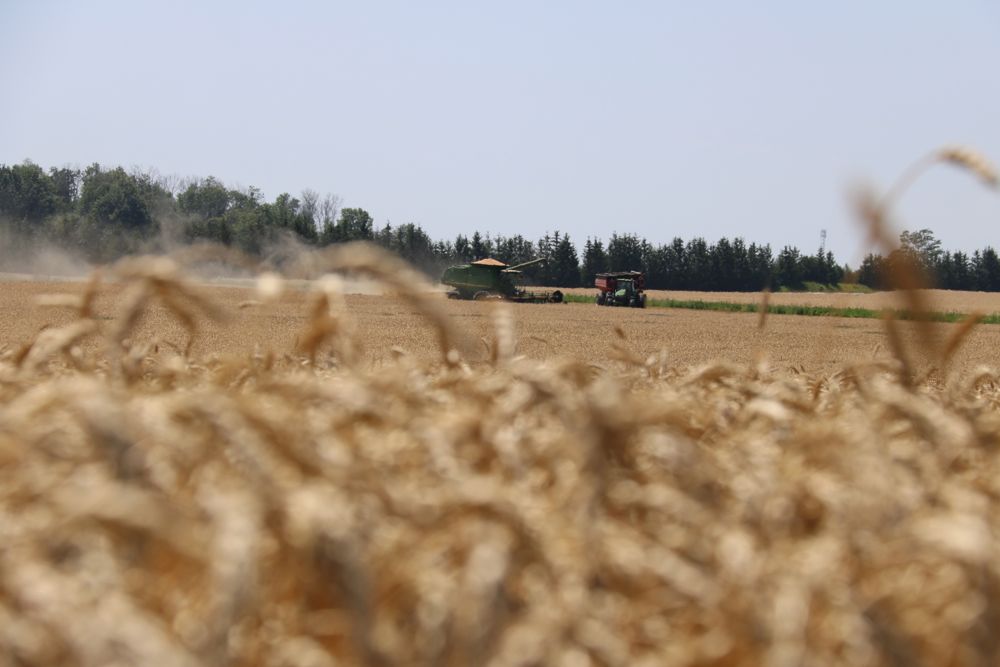Farming is a risky business. Each spring, corn growers go to the field and invest thousands in seed, fertilizer, herbicides and more, all in the hope that the crop will grow. We know the odds, and we ante up regardless.
The truth, however, is that the odds aren’t the same for everyone. Growers who do a better than average job of picking their hybrids essentially have an ace up their sleeve. If anyone is going to walk away from the table with money in their pockets, it’s probably going to be them.
Read Also

Could crop sharing be a viable option for your farm?
Crop sharing could be a good option for young and beginning farmers.
There’s no news in this. Or maybe there is. In reality, the world has changed with regard to hybrid selection. With the advent of biotechnology, corn hybrids have turned into much more than just “corn.” Bt hybrids were the first to make the jump, but as we look into 2012 there are myriad new traits built into new hybrids that make our purchase decisions that much more difficult.
Even with conventional traits, the game is different than it used to be. Improvements are coming faster than ever, which means it can take more effort just to keep up. Hybrids that used to last six or seven years, and sometimes more, now have an average lifespan of just four years.
In addition, there’s more than ever for farmers to think about because of changing condition in their own fields, says Dave Den Boer, manager of product development and agronomy with Pride Seeds. “Increased plant residues, adverse weather extremes and the onset of new insects and diseases are new factors that growers need to deal with.”
On the plus side, however, the overall field of hybrids is better than it has ever been. Basically, you can’t go too far wrong if you choose from any of the main genetics, says Pat Lynch, a Stratford-based certified crop adviser with an interest in hybrid selection since the 1970s.
“There’s not as much difference between hybrids as there used to be 10 years ago,” Lynch says.
Still, differences of 20 bushels per acre aren’t uncommon, and when Greg Stewart, the Ontario ag ministry’s corn guru, talks about hybrid selection, you can hear the capitals in his voice: “Seed is THE most important input,” Stewart says.
Then, you can multiply those yield impacts by today’s corn price, says Scott Fife, area agronomist for Eastern Ontario and the Maritimes with Pioneer Hi-Bred Limited. The result, says Fife, is one of the highest paybacks for any decision you will make all year.
Another way to look at it is that all the crop-management decisions you make before or after hybrid selection are focused on protecting the genetic yield potential of the hybrid. You only get one chance to select that basic potential.
Plus, selecting the right hybrid gives the best chance for good corn performance no matter what the growing season brings.
For example, in 2011, hybrids with excellent emergence and vigour scores paid off as seed was planted in less-than-ideal conditions. Hybrid choice nearly had to be vital in a different way too. The delayed planting meant hybrids that were faster to flower would have had a better chance to produce quality grain if there had been an early killing frost.
Besides, switching to the newest high-yielding hybrid a year earler than the next guy will give you a competitive advantage, says Stewart. “This is part of the art and science of farming,” says Stewart. By looking at the corn performance trial data and on-farm trial results, and diligently sorting out that data, a grower can be planting the new big hybrid before the rest of the township has picked up on it, Stewart continues.
In other words, the old days have disappeared when you could stay with a corn hybrid until you get conclusive on-farm proof that a new hybrid is better.
The key in making that move sooner rather than later is getting access to yield data wherever you can, and for that, Stewart and Lynch point first to the Ontario Corn Committee trials found at www.gocorn.net.
“It’ll get you in the mood,” says Lynch, who relishes the challenge of trying to pick the winning hybrids. The OCC reports make a good introduction and give some good background information, he adds. They’re also a good place to sort out the various traits without all the confusing company branding. For example, hybrids with resistance to corn borer are labelled B while D denotes hybrids with resistance to corn rootworm, W resistance to Western bean cutworm, etc.
However, the most important information sources, in Lynch’s opinion, are the dealer and the company websites. Lynch likes the Pioneer database and hopes other companies will follow suit with a similar format. “Their site has a significant amount of hybrid by population data,” says Lynch.
There are some things to keep in mind when reviewing the hybrid comparisons, cautions Lynch. Farmers need to look at the number of trials represented. “A minimum of six trials is required,” he says. He also urges farmers to consider the percentage wins and the size of the win. A really big win could mean the data is questionable, he says.
At one time, choosing a hybrid was a much simpler operation. A grower might have considered standability and yield and a few other factors, with seed price being one of them. Now there are multiple options and combinations of traits that growers need to assess, in contrast to yield potential alone.
In fact, Stewart says that agronomic considerations might actually be first and foremost. Regardless of the traits that are available, there may be some hybrids with elite high-yielding germplasm that work best on your farm.
Still, the western bean cutworm is an example of how the decision can rapidly get more complex. A relatively new pest in Ontario, we know the bean cutworm is not going away and it is overwintering in Ontario. Stewart says there were three times as many fields with western bean cutworm in 2011 compared to 2010, which resulted in a yield loss of five to seven bushels per acre in a fairly small geographic area. Growers over the last couple of years have been scrambling to choose the right trait to help fight the pest.
For producers growing corn after corn and farming in an area where this cutworm has been confirmed as a problem, there are two trait decisions. The producer would need a corn hybrid with rootworm control and a trait which helps fight western bean cutworm, such as Herculex, SmartStax or Viptera. If you don’t grow corn after corn or farm in an area where you do not anticipate western bean cutworm, these traits may be less valuable.
In other words, the days are long gone when all that mattered was finding the corn hybrid to give you higher yields. Now you also have to be aware of some of the pests which you might have to defend against on your farm. Corn hybrids with specific traits may be very valuable.
One of the benchmark criteria in the past has been standability for corn hybrids. In many ways it goes without saying that the hybrid with good standability will ultimately result in more grain in the tank. However, this isn’t always how it turns out.
Stewart says that in the past the harvest index, which is the percentage of the corn plant which is grain, was approximately 48 to 50 per cent. Now, some of the new elite high-yielding corn hybrids have harvest index numbers of 54, 56, 58 or 60 per cent. As long as you’ve got sufficient stalk strength, isn’t it better to put the extra resources into the ear?
One option for finding better hybrids is to get more outside support. “As with everything from marketing your grain to managing your investments, farmers are relying more and more on the advice of professionals in their field,” says Doug Alderman, national sales manager with Pride Seeds.
Yield, emergence, flowering, standability, disease resistance, dry-down and harvestability are all very important criteria when selecting a corn hybrid, Alderman says. With so many variables, it becomes a challenge to pick the winner.
Having a good relationship with your seed rep is essential, agrees Fife. It’s hard for growers to gather all the info on their own, especially with the fast turnover of hybrids today, he says.
Lynch agrees. “The seed rep is trained and has the knowledge,” Lynch says. “You need a good dealer you can trust… one you can count on for more than coats and hats, a dealer who thinks long term and not just this year’s sale.”
While Fife says data from trials on your farm is valuable, he also recommends looking at results further afield. These results will be a better predictor for next year, he says. Lynch also cautions farmers to be careful of results from their own farm trials when they don’t agree with other local comparisons. “Do not trust your own on-farm trials without looking elsewhere,” he says.
Fife advises farmers to volunteer for a research plot with a seed company. This allows growers to get a look at a hybrid a year before it’s widely available commercially. “You can try it before you have to buy large volumes,” he says. “We’re always on the lookout for volunteers.”
So when comparing hybrids, what factors should growers focus on? In Fife’s opinion, the big three are yield, maturity and standability. “After that, you need to look for traits that are specific to your own situation.” For example, a hog producer in southwestern Ontario will really want to look at giberella ear rot tolerance. And a no-till grower might look for stress emergence for cold ground.
Still, some of the old rules still apply, including the 60:20:20 ratio for selecting corn hybrids, where 60 per cent of your corn acres should be planted to a hybrid within your heat unit maturity, 20 per cent to a hybrid that is about 100 heat units later than your maturity and 20 per cent to a hybrid that is about the same amount earlier than your maturity.
Still, the best advice of all is to not put too much faith in your own ability to pick the winner.
Choosing a diverse lineup of locally adapted hybrids with varying maturities and agronomic strengths is one way to help manage weather and pest-related risks. Except in extraordinary circumstances, don’t plant more than about 25 per cent of the farm to any one hybrid, Fife says. “Unexpected things can happen.” CG















